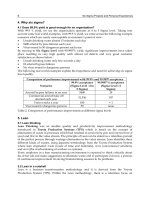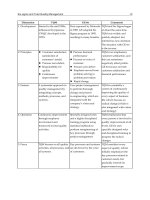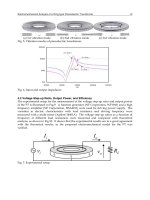Ebook Knowledge Management And Risk Strategies: Part 2.Pdf
Bạn đang xem bản rút gọn của tài liệu. Xem và tải ngay bản đầy đủ của tài liệu tại đây (485.98 KB, 63 trang )
November 28, 2006
16:53
WSPC/SPI-B434: Knowledge Management and Risk Strategiesp2_ch01
Part 2
HOW TO MANAGE KNOWLEDGE
SELECTION RISK
In Part 2, we will point out tasks that we face as knowledge selection risks emerge, and we will introduce infrastructures that society
should be provided with to manage knowledge selection risks, as
well as techniques for companies to reduce knowledge selection
risks.
November 28, 2006 16:53
WSPC/SPI-B434: Knowledge Management and Risk Strategiesp2_ch01
This page intentionally left blank
November 28, 2006
16:53
WSPC/SPI-B434: Knowledge Management and Risk Strategiesp2_ch01
Chapter 1
Tasks of Knowledge Selection Society
As we have seen in Part 1, most companies nowadays have to
abandon the lifetime employment policy, and employees have to
seek opportunities to gain new knowledge independently from
their organizations, as the lifespan of knowledge decreases and the
profitability of knowledge becomes insecure. This has the potential of
overthrowing the national structure of education and employment.
Knowledge selection risks consist of the danger of failing in
knowledge transfer, and the danger of the knowledge not returning
the expected profit.
For the former risk, there are those tasks such as securing the
necessary time, paying the fiscal costs and enhancing the efficiency
of knowledge transfer, to alleviate the risk. For the latter, the tasks are:
expand demand, predict demand accurately, and so on (see Table 16).
Table 16:
Tasks for Reducing Knowledge Selection Risks
Types of Risk
Tasks for Reducing the Risk
Alleviating knowledge
transfer failure risk
- Secure time cost
- Secure fiscal cost
- Improve knowledge transfer efficiency
(study efficiency)
Alleviating low
return risk
- Visualize knowledge
- Enhance demands
- Match demands and supplies
- Predict demands accurately
- Create knowledge
November 28, 2006
62
16:53
WSPC/SPI-B434: Knowledge Management and Risk Strategiesp2_ch01
Knowledge Management and Risk Strategies
Social agreement will be necessary to determine how much
knowledge transfer cost should be incurred, and by whom and how.
Companies cannot bear too much, and individual employees cannot
shoulder everything. But if nothing is done, unprofitable knowledge
assets in organizations will be steadily accumulated. This would lead
to a demise of even a leading company in time.
In Part 2, we will suggest measures to control knowledge selection
risks that society should be provided with, and the framework of the
new society, through the following four themes:
• Visualization of knowledge (construction of supply chain
management for knowledge)
In order to be justly evaluated according to its purpose, knowledge
and its related information need to be disseminated among people.
We will discuss the tasks necessary for the visualization of knowledge
and give some examples.
• Knowledge demand–supply matching (introduction of personnel supply derivatives)
The estimation of knowledge’s value is sometimes affected by the
motives of individuals. This causes an imbalance between the demand
and supply of knowledge. We will introduce the idea of personnel
supply derivative business as a measure to correct this imbalance.
• Securing knowledge transfer costs (work-sharing, knowledge
transfer time)
A knowledge transfer necessitates the knowledge transfer costs. How
to allocate them (particularly the associated time costs) among society,
firms and each individual would be one of the important themes in
constructing a new, sustainable society. In addition, a work-sharing
endeavor which helps alleviate the elevation of unemployment will
be explored as a means of allocating the knowledge transfer costs.
November 28, 2006
C.vT.Bg.Jy.Lj.Tai lieu. Luan vT.Bg.Jy.Lj. van. Luan an.vT.Bg.Jy.LjvT.Bg.Jy.LjvT.Bg.Jy.LjvT.Bg.Jy.LjvT.Bg.Jy.LjvT.Bg.Jy.LjvT.Bg.Jy.Lj. Do an.Tai lieu. Luan van. Luan an. Do an.Tai lieu. Luan van. Luan an. Do an
16:53
WSPC/SPI-B434: Knowledge Management and Risk Strategiesp2_ch01
Tasks of Knowledge Selection Society
63
• Efficacy of knowledge transfer systems
Efficient knowledge transfer with less time and cost is vital in this
climate of shortening knowledge lifecycle. Needless to say, the learner
has to have an avid interest in the new knowledge, but there are other
important techniques to acquire new knowledge in a limited time
frame. We will discuss the importance of knowledge transfer system
efficiency and give some examples.
@edu.gmail.com.vn.bkc19134.hmu.edu.vn
November 28, 2006 16:53
C.vT.Bg.Jy.Lj.Tai lieu. Luan vT.Bg.Jy.Lj. van. Luan an.vT.Bg.Jy.LjvT.Bg.Jy.LjvT.Bg.Jy.LjvT.Bg.Jy.LjvT.Bg.Jy.LjvT.Bg.Jy.LjvT.Bg.Jy.Lj. Do an.Tai lieu. Luan van. Luan an. Do an.Tai lieu. Luan van. Luan an. Do an
WSPC/SPI-B434: Knowledge Management and Risk Strategiesp2_ch01
This page intentionally left blank
@edu.gmail.com.vn.bkc19134.hmu.edu.vn
November 28, 2006
C.vT.Bg.Jy.Lj.Tai lieu. Luan vT.Bg.Jy.Lj. van. Luan an.vT.Bg.Jy.LjvT.Bg.Jy.LjvT.Bg.Jy.LjvT.Bg.Jy.LjvT.Bg.Jy.LjvT.Bg.Jy.LjvT.Bg.Jy.Lj. Do an.Tai lieu. Luan van. Luan an. Do an.Tai lieu. Luan van. Luan an. Do an
17:7
WSPC/SPI-B434: Knowledge Management and Risk Strategies p2_ch02
Chapter 2
Visualization of Knowledge Demand
2.1
The Current Situation
It is difficult to analyze if there is demand for a particular piece of
knowledge as we do not know which organization needs what kind
of knowledge, or where we can source the people with the necessary
knowledge. Quite often in job listings, exactly what kind of personnel are needed is left unclear, except in software and other industries
where specific qualifications are a prerequisite. This leads to job listings being incorrectly targeted and companies interviewing the wrong
candidates. Sometimes, because of this uncertainty in requirements,
those who are planning a new knowledge transfer may be unable to
grasp which knowledge is obsolete and which is not, and applicants
may join the wrong companies.
2.2
Solutions (Supply Chain Management
for Knowledge)
In this section, we will propose a system for sharing information
on supply/demand data among interested parties, and discuss the
importance of advisory institutions that offer interpretation of
information to corporate and individual clients.
1)
Standardization of knowledge
@edu.gmail.com.vn.bkc19134.hmu.edu.vn
Individual users need to have some idea of what the knowledge
is about if they are to obtain new knowledge. For that purpose,
November 28, 2006
C.vT.Bg.Jy.Lj.Tai lieu. Luan vT.Bg.Jy.Lj. van. Luan an.vT.Bg.Jy.LjvT.Bg.Jy.LjvT.Bg.Jy.LjvT.Bg.Jy.LjvT.Bg.Jy.LjvT.Bg.Jy.LjvT.Bg.Jy.Lj. Do an.Tai lieu. Luan van. Luan an. Do an.Tai lieu. Luan van. Luan an. Do an
66
17:7
WSPC/SPI-B434: Knowledge Management and Risk Strategies p2_ch02
Knowledge Management and Risk Strategies
knowledge has to be defined and designated. Also, for the acquired
knowledge to be used in different organizations, terms and criteria
have to be standardized. When knowledge is standardized, its usage
will increase and its demand will expand.
In scholarship, knowledge is standardized by the systematic
compilation of textbooks. In business, it is conducted by
“standardization”, sorting the knowledge necessary to each business.
For example, the Ministry of Economy, Trade and Industry in
Japan made “IT skill standards” public, as the index for the IT skills
necessary for IT related services. This was an attempt to establish a
framework for the training of IT specialists, itemizing the skills necessary to offer IT services and sorting them objectively and practically.
IT services are divided into several “types of jobs”, each with its
“performance index” and “skills”. “Skills” are further itemized into
“proficiency level” and “knowledge”. There is also a “skill framework”
offering an overall picture of the IT skill index.
Electronic manufacturers, including Hitachi, Toshiba, Matsushita and NEC, have set up a job training scheme for their union
members.1 The objective of this scheme is to facilitate mid-career job
change both within one company and within the industry. Union
members can avail themselves of language courses and other courses
designed to help them gain specific qualifications, held by those companies. By introducing qualifications, the skills of union members
who have completed the courses can be seen, facilitating career change
within the industry.
2) Visualization of personnel information
To enable successful knowledge selection, it is vital to assess the
performance of the person who practices the knowledge, as well
as the knowledge itself. Most Japanese companies used to withhold
information about their employees’ abilities. This might have worked
@edu.gmail.com.vn.bkc19134.hmu.edu.vn
1
“Hitachi, Toshiba, and other Electronics Manufacturers Set Up Training Courses,”
Nihon Keizai Shimbun, 2 January 2002.
November 28, 2006
C.vT.Bg.Jy.Lj.Tai lieu. Luan vT.Bg.Jy.Lj. van. Luan an.vT.Bg.Jy.LjvT.Bg.Jy.LjvT.Bg.Jy.LjvT.Bg.Jy.LjvT.Bg.Jy.LjvT.Bg.Jy.LjvT.Bg.Jy.Lj. Do an.Tai lieu. Luan van. Luan an. Do an.Tai lieu. Luan van. Luan an. Do an
17:7
WSPC/SPI-B434: Knowledge Management and Risk Strategies p2_ch02
Visualization of Knowledge Demand
67
well in the lifetime employment system, where employees competed
against each other, playing by their own companies’ rules. However,
it is not very rational if employees are to choose knowledge that will
be their own personal asset.
NEC has made the duties and responsibilities of management
level employees (approximately 12,000 employees) internally public
online.2 Since salary is determined by duties, all employees can now
grasp how much management is paid.
Fuji Xerox has an intriguing scheme.3 It was reported that they
would start a new scheme, in which employees’ market value would
be calculated by an external institution and reported back to the
employees. They would also publish duties, responsibilities and standards for payment, just like NEC.
3) Supply chain management for knowledge
A proactive standards agency in the industry would help in the
standardization of knowledge, as it is beyond a single individual
company’s power to establish industry standards, which requires an
intimate knowledge of the needs of interested parties. A system will
be needed to share information among people who use a particular piece of knowledge and to augment its standardization. This is
called Supply Chain Management for Knowledge (SCMK).
In the manufacturing industry, groups of parties involved in
the production and distribution of products are called “supply
chains”. Supply chains manage supply/demand information and
inventory, so that they can maximize sales and minimize inventory.
This is called Supply Chain Management (SCM), a scheme which
builds networks within the chain and manages the data concerning
production, inventory, and sales and planning at each level, so that
inventory at all levels can be optimized.
2
“NEC Internally Published Management Grade Responsibilities,” Nihon Keizai
Shimbun, 28 March 2002.
3
“Fuji Xerox: Assessment of Employee Marketability,” Nikkei Sangyo Shimbun, 1 April
2002.
@edu.gmail.com.vn.bkc19134.hmu.edu.vn
November 28, 2006
C.vT.Bg.Jy.Lj.Tai lieu. Luan vT.Bg.Jy.Lj. van. Luan an.vT.Bg.Jy.LjvT.Bg.Jy.LjvT.Bg.Jy.LjvT.Bg.Jy.LjvT.Bg.Jy.LjvT.Bg.Jy.LjvT.Bg.Jy.Lj. Do an.Tai lieu. Luan van. Luan an. Do an.Tai lieu. Luan van. Luan an. Do an
68
17:7
WSPC/SPI-B434: Knowledge Management and Risk Strategies p2_ch02
Knowledge Management and Risk Strategies
This works well for manufacturing. However, it might not when it
comes to human resources. Knowledge is practiced by human beings.
Men cannot be stored in storehouses like product parts. Companies
have to be provided with the right number of personnel at the exact
moment.
It would improve the visibility of knowledge demand if
knowledge demand in companies is analyzed, and if that data are
shared among the knowledge supply chains, which consist of recruitment companies, educational institutes and interested employees (see
Figure 19).
Many companies are currently working on the construction of
SCM concerning parts and material supply. They only have to include knowledge in their SCM schemes. By using this new scheme,
SCMK, companies will be able to convey their knowledge demand
to their supply chains. By sharing supply and demand information,
all parties involved can optimize their supply/demand planning.
Furthermore, if recruitment companies are involved in other
companies’ SCMK, they would also be able to promote the
standardization of knowledge using the data on other companies’
needs and convey generalized needs to educational institutions.
In the past, when companies hired new graduates as engineers,
some companies allocated the numbers of positions to each school
and demanded school recommendations. This can be thought as a
type of personnel supply chain between companies and schools. This
practice, however, left the standard for personnel assessment and
demand information unclear, making it almost impossible to attempt
standardization of information on the supply side. The only options
applicants had were “companies”, not positions. If knowledge supply
chains could be constructed, the supply and demand of knowledge
would be visualized, strongly propelling knowledge standardization.
There are examples of cooperation between “educational institutions and recruitment agencies” and between “educational
institutions and companies”, such as AMS Japan and Temp Staff,4
@edu.gmail.com.vn.bkc19134.hmu.edu.vn
4
“AMS Japan and Temp Staff Collaborate in IT Personnel Training,” Nihon Keizai
C.vT.Bg.Jy.Lj.Tai lieu. Luan vT.Bg.Jy.Lj. van. Luan an.vT.Bg.Jy.LjvT.Bg.Jy.LjvT.Bg.Jy.LjvT.Bg.Jy.LjvT.Bg.Jy.LjvT.Bg.Jy.LjvT.Bg.Jy.Lj. Do an.Tai lieu. Luan van. Luan an. Do an.Tai lieu. Luan van. Luan an. Do an
Applicants
Applicants
Educational
institutions
Educational
institutions
Educational
institutions
Recruitment
agencies
Applicants
Applicants
Applicants
Companies
Projects
Educational
institutions
Educational
institutions
Educational
institutions
Recruitment
agencies
Projects
Visualization of Knowledge Demand
Promotion of shared
information standardization
Projects
Applicants
Shared information
Demand: kinds of
knowledge, periods, etc.
Supply: number of
eligible employees
Companies
Projects
Projects
Optimization of demand plan
Optimization of supply plan
The Image of SCMK
@edu.gmail.com.vn.bkc19134.hmu.edu.vn
Projects
69
Figure 19:
Optimization of demand plan
Optimization of supply plan
November 28, 2006
C.vT.Bg.Jy.Lj.Tai lieu. Luan vT.Bg.Jy.Lj. van. Luan an.vT.Bg.Jy.LjvT.Bg.Jy.LjvT.Bg.Jy.LjvT.Bg.Jy.LjvT.Bg.Jy.LjvT.Bg.Jy.LjvT.Bg.Jy.Lj. Do an.Tai lieu. Luan van. Luan an. Do an.Tai lieu. Luan van. Luan an. Do an
70
17:7
WSPC/SPI-B434: Knowledge Management and Risk Strategies p2_ch02
Knowledge Management and Risk Strategies
Digital Hollywood’s consortium,5 and Manpower Japan’s online
staffing business.6
AMS Japan, a personnel training company, collaborates with
Temp Staff, a recruitment agency, in the area of IT personnel.
AMS Japan offers special courses to personnel registered with Temp
Staff, and Temp Staff sends members who have gained specialist
knowledge through these courses to client companies. In one of
the training courses, “Net Professional (campaign basic)”, they teach
applicants how to construct networks, for example, how to connect
cables, and techniques required for CCNA, one of the qualifications
granted by Cisco Systems.
Digital Hollywood, an IT engineer training school, has formed
a consortium called “Digital Hollywood Partners” with 20 major
corporations, such as Matsushita Electric Industrial Co Ltd. Digital
Hollywood recommends its students and graduates as on-thejob trainees or permanent employee candidates to the companies,
and the companies develop courses such as CRM and Marketing
together, when there is demand for them, and market them for inhouse training too. The consortium facilitates procurement of personnel with a basic knowledge of IT technology. Personnel, therefore,
will not need training after joining the companies. The consortium
also holds gatherings that offer opportunities for member companies
to exchange information.
Manpower Japan developed a system to manage a variety of
information through the Internet, from information about business
with client companies to data on staff ’s working hours. This is called
“Manpower E-solutions”, and it enables companies to type in duty
and types of job, qualifications, positions and fees, to receive information from Manpower concerning the status of the recruitment
process.
5
“Collaboration of Major IT Engineer Training Firms,” Nihon Keizai Shimbun, 21
January 2002.
6
“Online Temporary Staffing Business, Manpower,” Nikkei Sangyo Shimbun, 28
January 2002.
@edu.gmail.com.vn.bkc19134.hmu.edu.vn
November 28, 2006
C.vT.Bg.Jy.Lj.Tai lieu. Luan vT.Bg.Jy.Lj. van. Luan an.vT.Bg.Jy.LjvT.Bg.Jy.LjvT.Bg.Jy.LjvT.Bg.Jy.LjvT.Bg.Jy.LjvT.Bg.Jy.LjvT.Bg.Jy.Lj. Do an.Tai lieu. Luan van. Luan an. Do an.Tai lieu. Luan van. Luan an. Do an
17:7
WSPC/SPI-B434: Knowledge Management and Risk Strategies p2_ch02
Visualization of Knowledge Demand
71
As for knowledge standardization for the purpose of sharing
information, three major companies, including Pasona, Temp Staff
and Recruit Staffing, decided to standardize their online application
systems, enabling clients to use the same format for types of job,
proficiency, methods of charging fees, and management of actual
working hours of temping staff.7
4)
Personnel suppliers and career planning advisors
As various information about the supply and demand of knowledge
or about knowledge transfer is shared among concerned parties, it
becomes important to interpret the gained information accurately.
Specialist advice would be a great help to generate profits, further
enhancing the visibility of knowledge. As employees and companies
are not familiar with information about knowledge, they can select
knowledge more efficiently in choosing new personnel or in designing
their career paths, if they are provided with specialist advice. The
demand for advisors is expected to increase in the future.
There is no example of advisors specializing in supply–demand
information analysis as of yet, but in terms of out-placement
counseling, there is the case of Japan Drake Beam Morin (DBM
Japan).8 DBM Japan started a training course for career counselors
in April 2002. In this course, students learn basic information about
employment, mental health care for job applicants, and know-how
for out-placement during the three months of the course, and are
then granted a qualification from DBM Japan.
7
“Online Application to be Standardized in June,” Nihon Keizai Shimbun, 12 April
2002.
8
“DBM Japan to Join the Career Counselor Business,” Nihon Keizai Shimbun, 3
January 2002.
@edu.gmail.com.vn.bkc19134.hmu.edu.vn
November 28, 2006 17:7
C.vT.Bg.Jy.Lj.Tai lieu. Luan vT.Bg.Jy.Lj. van. Luan an.vT.Bg.Jy.LjvT.Bg.Jy.LjvT.Bg.Jy.LjvT.Bg.Jy.LjvT.Bg.Jy.LjvT.Bg.Jy.LjvT.Bg.Jy.Lj. Do an.Tai lieu. Luan van. Luan an. Do an.Tai lieu. Luan van. Luan an. Do an
WSPC/SPI-B434: Knowledge Management and Risk Strategies p2_ch02
This page intentionally left blank
@edu.gmail.com.vn.bkc19134.hmu.edu.vn
November 28, 2006
C.vT.Bg.Jy.Lj.Tai lieu. Luan vT.Bg.Jy.Lj. van. Luan an.vT.Bg.Jy.LjvT.Bg.Jy.LjvT.Bg.Jy.LjvT.Bg.Jy.LjvT.Bg.Jy.LjvT.Bg.Jy.LjvT.Bg.Jy.Lj. Do an.Tai lieu. Luan van. Luan an. Do an.Tai lieu. Luan van. Luan an. Do an
20:48
WSPC/SPI-B434: Knowledge Management and Risk Strategiesp2_ch03
Chapter 3
Matching of Knowledge Supply and Demand
3.1
The Current Situation
A company will suffer from a dilemma if it meets a practitioner of
knowledge who is needed for a project that has not yet commenced.
If they wait until the project is officially launched, other companies
might hire the personnel, but if they hire him before the official
inauguration of the project, there is a risk that the project may never
materialize.
Also, if the prospect of knowledge bearing profit is lowered, learners may hesitate to choose that knowledge, resulting in difficulties in
personnel procurement for companies when there is demand for that
particular knowledge. Is there any way of facilitating the distribution
of knowledge (personnel), whilst lowering the low-return risk of
knowledge?
3.2
Solutions (Personnel Supply Derivative Business)
In this section, we will propose employment transactions modeled
on financial derivatives, and explain how to manage the knowledge
selection risks when this model is used.
1)
Introduction of personnel supply derivative business
When knowledge is standardized and a market is formed where
supply/demand information can be matched, it is possible to reserve
personnel who possess knowledge, or to draw “supply option”
@edu.gmail.com.vn.bkc19134.hmu.edu.vn
November 28, 2006
C.vT.Bg.Jy.Lj.Tai lieu. Luan vT.Bg.Jy.Lj. van. Luan an.vT.Bg.Jy.LjvT.Bg.Jy.LjvT.Bg.Jy.LjvT.Bg.Jy.LjvT.Bg.Jy.LjvT.Bg.Jy.LjvT.Bg.Jy.Lj. Do an.Tai lieu. Luan van. Luan an. Do an.Tai lieu. Luan van. Luan an. Do an
20:48
WSPC/SPI-B434: Knowledge Management and Risk Strategiesp2_ch03
74
Knowledge Management and Risk Strategies
Table 17:
Personnel Supply Derivative Business
Personnel Contract
Personnel supply option
Personnel supply reservation
Personnel supply swap
Content
Contract concerning rights to supply, or to be supplied,
personnel with particular knowledge for a certain
period of time
A right to supply personnel with particular knowledge
for a certain period of time
Contract to mutually exchange personnel with certain
knowledge
contracts, based on the standardized knowledge. Table 17 shows an
example of a personnel supply derivative contract.
If personnel supply options are available, it becomes possible to
guarantee personnel supply at low cost by setting up appropriate conditions of use. Also, through personnel supply reservation, personnel
can be stably supplied and positions can be secured, regardless of
supply and demand in the market. Personnel supply swap enables
the correction of uneven personnel distribution among companies.
As for temporary employment, the Labor Standards Law
(amended) (enacted in 1998, implemented in April 1999) allowed
employees in highly specialized areas to negotiate contracts of up to
three years; this included doctors, scholars, lawyers and chartered
accountants. Subsequently, in December 2001, the Council for
Regulatory Reform published “Remarks on Regulatory Reforms”,
arguing that areas of specialist jobs should be further expanded.1
In real life, there have been examples of outsourcing personnel
for intellectual labor, using contract temping staff.2 Kao Corporation
was reported to have drawn up nondisclosure agreements with about
a dozen of temping staff holding master’s degrees or doctoral degrees
for highly specialized jobs in the composition and analysis of chemical
products in spring 2001.
1
“Temporary Staffing: Professional Career to be Expanded,” Nihon Keizai Shimbun,
28 January 2002.
2
“Employment Fault 2,” Nihon Keizai Shimbun, 24 December 2001.
@edu.gmail.com.vn.bkc19134.hmu.edu.vn
November 28, 2006
C.vT.Bg.Jy.Lj.Tai lieu. Luan vT.Bg.Jy.Lj. van. Luan an.vT.Bg.Jy.LjvT.Bg.Jy.LjvT.Bg.Jy.LjvT.Bg.Jy.LjvT.Bg.Jy.LjvT.Bg.Jy.LjvT.Bg.Jy.Lj. Do an.Tai lieu. Luan van. Luan an. Do an.Tai lieu. Luan van. Luan an. Do an
20:48
WSPC/SPI-B434: Knowledge Management and Risk Strategiesp2_ch03
Matching of Knowledge Supply and Demand
75
Canon also outsources 7100 employees, out of which 1700
personnel are engaged in research and development departments. Personnel supply derivative contracts provide various solutions to corporations needing different personnel at different times (see Figure 20).
Fullcast, a recruitment agency, has announced that they would
enlarge the number of registered staff for catering establishments
to approximately 10,000 members by 2004.3 As staff turnover is
high and the business fluctuates seasonally in the catering industry, Fullcast would prepare an expeditious supply of personnel, providing registered staff with training before sending them to client
establishments.
As for other similar personnel supply option systems, there is the
example of the Self-Defense Forces reserve. The reserve system was
established in 1954 to secure personnel for Self-Defense Forces by
engaging reserve forces as SDF personnel. A monthly wage of 4000
JPY and a daily training fee of 8100 JPY are paid to Reserve forces.4
2)
Measures for career planning
The personnel supply derivative business is expected to contribute to
the stabilization of the labor market, and to produce new business
ideas for personnel management. Conventionally, the career paths
of employees were passively formed under the lifetime employment system. The personnel supply derivative business would enable
employees to actively plan their career paths (see Figure 21).
For example, each individual receives option fees for a certain
period of time in his future through personnel supply reservation contracts or supply option contracts with companies through
recruitment agencies, alleviating the low-return risk of knowledge
to a certain extent. It provides companies with personnel with the
3
“Powerful Ally of Busy Drinking and Eating Establishments, Fullcast: Registered
Members 10,000,” Nihon Keizai Shimbun, 1 April 2002.
4
/>@edu.gmail.com.vn.bkc19134.hmu.edu.vn
C.vT.Bg.Jy.Lj.Tai lieu. Luan vT.Bg.Jy.Lj. van. Luan an.vT.Bg.Jy.LjvT.Bg.Jy.LjvT.Bg.Jy.LjvT.Bg.Jy.LjvT.Bg.Jy.LjvT.Bg.Jy.LjvT.Bg.Jy.Lj. Do an.Tai lieu. Luan van. Luan an. Do an.Tai lieu. Luan van. Luan an. Do an
76
(1) Personnel supply option (in the case of calls)
Recruitment
agencies
Corporations
Practitioners of
knowledge
Corporations pay option fees to purchase rights to hire practitioners of knowledge X for a
certain period of time from a certain date. Recruitment agencies have the responsibility of
supplying them with personnel as promised when they exercise their rights.
(2) Personnel supply reservation
Recruitment
agencies
Corporations
Practitioners of
knowledge
(3) Personnel supply reservation
Practitioner of
Knowledge A
Corporations
Practitioner of
Knowledge B
Corporations
Corporations exchange practitioners of knowledge A with practitioners of knowledge B for a
certain period of time.
Figure 20:
Personnel Supply Derivative Contract Model
@edu.gmail.com.vn.bkc19134.hmu.edu.vn
Knowledge Management and Risk Strategies
Corporations pay reservation fees to reserve practitioners of knowledge X for employment
for a certain period of time from a certain date. Recruitment agencies have the
responsibility of supplying them with personnel as promised.
C.vT.Bg.Jy.Lj.Tai lieu. Luan vT.Bg.Jy.Lj. van. Luan an.vT.Bg.Jy.LjvT.Bg.Jy.LjvT.Bg.Jy.LjvT.Bg.Jy.LjvT.Bg.Jy.LjvT.Bg.Jy.LjvT.Bg.Jy.Lj. Do an.Tai lieu. Luan van. Luan an. Do an.Tai lieu. Luan van. Luan an. Do an
Age 20
Age 30
Age 40
Age 50
Age 60
Age 70
Employee A
Personnel supply
reservation
(knowledge of
program
development)
Personnel supply
option (knowledge of
project management)
Personnel supply
option (knowledge of
accounting and of
law)
Matching of Knowledge Supply and Demand
A case of the Software Industry
Personnel supply
option (knowledge of
project management)
(multiple experiences)
Recruitment
agencies
Corporation
A
Corporation
B
Recruitment
agencies
Corporation
C
Recruitment
agencies
Corporation
D
Career Design by Personnel Derivative Business in the Software Industry
@edu.gmail.com.vn.bkc19134.hmu.edu.vn
77
Figure 21:
Recruitment
agencies
November 28, 2006
C.vT.Bg.Jy.Lj.Tai lieu. Luan vT.Bg.Jy.Lj. van. Luan an.vT.Bg.Jy.LjvT.Bg.Jy.LjvT.Bg.Jy.LjvT.Bg.Jy.LjvT.Bg.Jy.LjvT.Bg.Jy.LjvT.Bg.Jy.Lj. Do an.Tai lieu. Luan van. Luan an. Do an.Tai lieu. Luan van. Luan an. Do an
78
20:48
WSPC/SPI-B434: Knowledge Management and Risk Strategiesp2_ch03
Knowledge Management and Risk Strategies
necessary knowledge, too. If there is a downturn in business they can
withdraw their option rights.
Of course, it is possible for each individual employee to contract
with companies directly. However, this is risky for corporations as
it is difficult to judge if the employee has acquired the necessary
knowledge by the time of the project. Therefore, it makes more sense
if recruitment agencies manage contracts for groups of applicants.
As for the SDF reserve, there is a further auxiliary system
called “Assistant Reserve System”. When applicants pass the entrance
examination and go through training (such as combat training) in
the three year period in the free time they have while being engaged
in other jobs, they will receive the total sum of 395,000 JPY, and
they are entitled to become SDF reserve personnel after completing the training even if they are not retired SDF personnel. This
system was started in 2002 and has been reported to have proven
extremely popular, with applications running at six times the number of positions available.5
@edu.gmail.com.vn.bkc19134.hmu.edu.vn
5
“Young Applicants Swarming to Entrance Examination of SDF Assistant Reserve,”
Yomiuri Online, 14 April 2002 ( />
November 28, 2006
C.vT.Bg.Jy.Lj.Tai lieu. Luan vT.Bg.Jy.Lj. van. Luan an.vT.Bg.Jy.LjvT.Bg.Jy.LjvT.Bg.Jy.LjvT.Bg.Jy.LjvT.Bg.Jy.LjvT.Bg.Jy.LjvT.Bg.Jy.Lj. Do an.Tai lieu. Luan van. Luan an. Do an.Tai lieu. Luan van. Luan an. Do an
20:50
WSPC/SPI-B434: Knowledge Management and Risk Strategiesp2_ch04
Chapter 4
Securing the Time Cost of Knowledge Transfer
4.1
The Current Situation
It takes time to understand and practice knowledge. However, most
people lead busy lives, having little time for learning new knowledge. Currently, many companies are attempting to restructure by
reducing personnel, which necessitates the remaining personnel to
cover the extra workload by working longer hours. This deprives the
employees of their opportunities to develop their skills, eventually
lowering liquidity in the labor market.
4.2
Solutions
In this section, we will propose work-sharing as a measure to
secure the time cost of knowledge transfer, and demonstrate how
work-sharing schemes can be utilized to create time for knowledge
transfer.
1) Work-sharing as a measure to secure knowledge
transfer time
Work-sharing means: “To share a certain amount of workload
among many employees by shortening working hours to secure
employment”.1 It has come to the attention of Japanese society as
a means to ease employment insecurity, since there have been many
@edu.gmail.com.vn.bkc19134.hmu.edu.vn
1
Shinmura, Izuru, et al., Kojien, Iwanami Shoten, 1998.
November 28, 2006
C.vT.Bg.Jy.Lj.Tai lieu. Luan vT.Bg.Jy.Lj. van. Luan an.vT.Bg.Jy.LjvT.Bg.Jy.LjvT.Bg.Jy.LjvT.Bg.Jy.LjvT.Bg.Jy.LjvT.Bg.Jy.LjvT.Bg.Jy.Lj. Do an.Tai lieu. Luan van. Luan an. Do an.Tai lieu. Luan van. Luan an. Do an
80
20:50
WSPC/SPI-B434: Knowledge Management and Risk Strategiesp2_ch04
Knowledge Management and Risk Strategies
recent cases of cutbacks as the unemployment rate has hit record
heights since World War II.
“Survey Report on Work-Sharing” by the then Ministry of
Labor classifies work-sharing schemes into four patterns as shown
in Table 18.2 What is notable here is the Diversified Working Patterns Type, which can be used as a measure to manage knowledge
selection risks.
The Netherlands suffered a long-term recession as a result of the
two oil crises since the 1970s, and the government has attempted
major changes to the tax system, social security system, and labor law
since 1982. The main changes include equal treatment of full-time
and part-time workers and strict limitations on layoffs or dismissal —
full-time and part-time workers were granted equal treatment and
equal payment per hour for the same jobs, and companies were
forced to obtain the regulator’s permission and to present written
documents regarding the grounds of dismissal before discharging
employees. The success of these changes resulted in a decrease in the
unemployment rate, which fell to less than 3%, and the national fiscal
budget expenditure has turned positive for the first time in 25 years
in 2000.
The Netherlands created a large number of part-time jobs through
work-sharing, forming a work environment with values completely
different from that of Japan. With the government’s policies enforcing
more strict rules on dismissal and promoting a shift from full-time
to part-time work, employees were enabled to choose working hours
that suited their lifestyle, and companies to control employment
more smoothly.
Work-sharing can also be considered as a means to secure
knowledge transfer time, as the extra free time created by worksharing can be allocated to acquiring new knowledge. Although
work-sharing is commonly regarded as a measure to create jobs
for blue-collar workers, sharing menial labor, it has been put to
@edu.gmail.com.vn.bkc19134.hmu.edu.vn
2
Mitsui Knowledge Industry, Research Institute, commissioned by the then Ministry
of Labor, “Survey Report on Work-Sharing,” April 2001.
November 28, 2006
C.vT.Bg.Jy.Lj.Tai lieu. Luan vT.Bg.Jy.Lj. van. Luan an.vT.Bg.Jy.LjvT.Bg.Jy.LjvT.Bg.Jy.LjvT.Bg.Jy.LjvT.Bg.Jy.LjvT.Bg.Jy.LjvT.Bg.Jy.Lj. Do an.Tai lieu. Luan van. Luan an. Do an.Tai lieu. Luan van. Luan an. Do an
20:50
WSPC/SPI-B434: Knowledge Management and Risk Strategiesp2_ch04
Securing the Time Cost of Knowledge Transfer
Table 18:
Patterns
81
Patterns of Work-Sharing and Examples of Cases
Purpose
Cases of Implementation
Emergency
Measure Type
Shorten the working
hours of each employee
to secure employment
for the whole company
as an emergency
measure to survive
temporary recession
Outside Japan, companies
issue various benefits
to alleviate loss of wage
from the shortening of
working hours. In
Japan, there have been
cases in which
employees received
lower wage as a result
of this measure. Some
companies limit the
number of employees
who are affected to
lessen the objection
from employees
Measure Aimed at
Middle-Aged
and Elderly
Workers Type
Shorten the working
hours of each employee
to procure more jobs
to secure employment
for middle-aged and
elderly employees
Measures to secure
employment for
employees over 60
(delayed retirement age
and reemployment,
etc.) in Japan
Job Creation Type
Shorten the working
hours at corporate or
national level to create
new job openings for
the unemployed
In European countries,
governments grant
benefits to alleviate the
burden of companies
and employees. Some
companies shorten the
working hours of
elderly workers to
create jobs for young
workers
Diversified
Working
Patterns Type
Diversify working
patterns of permanent
employees to create
more job opportunities
for more employees
including women and
elderly workers
In the Netherlands, equal
treatment for part-time
workers was granted by
a tripartite agreement,
greatly promoting
part-time jobs. Job
sharing is another
example of attempts in
this category in other
countries
@edu.gmail.com.vn.bkc19134.hmu.edu.vn
November 28, 2006
C.vT.Bg.Jy.Lj.Tai lieu. Luan vT.Bg.Jy.Lj. van. Luan an.vT.Bg.Jy.LjvT.Bg.Jy.LjvT.Bg.Jy.LjvT.Bg.Jy.LjvT.Bg.Jy.LjvT.Bg.Jy.LjvT.Bg.Jy.Lj. Do an.Tai lieu. Luan van. Luan an. Do an.Tai lieu. Luan van. Luan an. Do an
82
20:50
WSPC/SPI-B434: Knowledge Management and Risk Strategiesp2_ch04
Knowledge Management and Risk Strategies
use for white-collar workers, too. At Hewlett Packard, workers are
allowed to share a workload that is normally for one employee
between two, one employee working in the mornings, the other in
the evenings, or one on certain days and the other the rest of the
week. Applicants can choose their own partners, and they will be
assessed in pairs for performance and promotion. Sun Microsystems
has similar schemes.
There are still unresolved issues, such as how much lower wages
resulting from the shortened working hours employees can accept, or
how far work can be shared when the area of responsibility is unclear.
It is, however, a concrete measure against knowledge obsolescence to
secure the necessary study time for acquiring new knowledge.
2)
Diversified Working Patterns Type work-sharing
(new lifestyles in the Netherlands)
In the Netherlands, where Diversified Working Patterns Type
work-sharing has been successfully introduced, various new lifestyles
have appeared. According to Toshihisa Nagasaka, there are three
working types: “Full-time with two days off, 36–38 working hours”,
“part-time with three days off, 30–32 working hours”, and “half-time
with half a week off, 20 working hours”. Employees can select the
working types that suit their situation (children, activities, study, etc.)
and shift to different patterns if there is change in their lives.
The national government of the Netherlands recommends a “1.5
model” for couples (see Figure 22). Say if the husband works in an
office and the wife does the house work, it is 1.0, and if both husband
and wife work, it is 2.0. They recommend husband and wife working
1.5 in total as a couple. However, it has been pointed out that even
in the Netherlands today, it is only a percentage of relatively young
workers in the service industry in the cities who have managed the
1.5 model.3
@edu.gmail.com.vn.bkc19134.hmu.edu.vn
3
“The Actual Conditions of the Netherlands Model,” ( />zakkan/zakkan13/dutch.html).
November 28, 2006
C.vT.Bg.Jy.Lj.Tai lieu. Luan vT.Bg.Jy.Lj. van. Luan an.vT.Bg.Jy.LjvT.Bg.Jy.LjvT.Bg.Jy.LjvT.Bg.Jy.LjvT.Bg.Jy.LjvT.Bg.Jy.LjvT.Bg.Jy.Lj. Do an.Tai lieu. Luan van. Luan an. Do an.Tai lieu. Luan van. Luan an. Do an
20:50
WSPC/SPI-B434: Knowledge Management and Risk Strategiesp2_ch04
Securing the Time Cost of Knowledge Transfer
Husband (age unknown)
Type of business: financial
carrier
Job description: accountant
Position: accounting manager
in the sales department
Working pattern: full-time
Wife (36)
Type of business: investment
bank
Job description: administration
Position: project manager
Working pattern: 3 days a week
from Monday to Wednesday
(approximately 21 hours)
Husband (36)
Type of business: natural
fertilizer manufacturer
Job description: sale staff
Position: project manager
Working pattern: 4.5 days a
week (33.5 hours)
Wife (36)
Type of business: natural park
management volunteer
organization
Job description: support staff
for owner and staff
Position: PA
Working pattern: 3 days a week
(13 hours)
Husband (38)
Type of business: education
Job description: semi-civil
servant
Position: backup coordinator
Working pattern: 4 days a week
(29.5 hours)
Wife (age unknown)
Type of business: banking
Job description: unknown
Position: unknown
Working pattern: 4 days a week
(32 hours)
Figure 22:
3)
83
Examples of Couples’ Working Patterns in The Netherlands4
Securing time cost by work-sharing schemes
Some kinds of knowledge require a considerable amount of time
to acquire. Most companies offer paid leave, but taking a few
months off is not practical as paid leave is not inexhaustible.
Figure 23 demonstrates how a variant of work-sharing schemes
enables employees to secure a block of time for knowledge transfer. For example, Tanaka does Task A full-time, and can use up the
leave from Task A period during the period of Task B. This lowers
the income, but it allows employees to secure both free time and the
present employment.
@edu.gmail.com.vn.bkc19134.hmu.edu.vn
4
“Couples in Work-Sharing Advanced Country, The Netherlands,” Travaille,
16 January 2001, No. 3.









